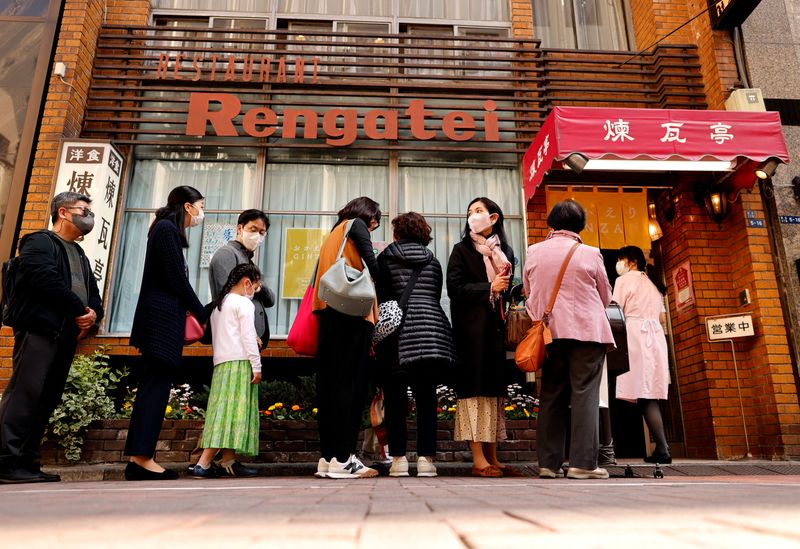‘Omurice’, comfort food for Japanese and Koreans, a symbol of warmer ties
2023.03.16 02:54
2/2

© Reuters. People form a line as they try to have lunch at Rengatei, a popular and long-established restaurant specialising in Japanese-style Western dishes, at Ginza district in Tokyo, Japan March 16, 2023. REUTERS/Issei Kato
2/2
By Kantaro Komiya
TOKYO (Reuters) – Nearly everything about South Korean President Yoon Suk Yeol’s first summit with Japanese Prime Minister Fumio Kishida in Tokyo will be scrutinised for signs of warmer bilateral ties, including a shared meal of a Tokyo classic called omurice.
The dish, whose name is a mash-up of omelette and rice, has become the talk of the town since Japan’s Fuji TV reported on Monday of a hushed plan for Kishida to treat Yoon at Rengatei, the storied but no-frills restaurant that invented it.
Yoon, a self-described foodie and avid cook, reportedly had “unforgettable” memories of the omurice he ate in his youth at the 128-year-old establishment in Tokyo’s Ginza district. He made frequent trips to the Japanese capital in 1966 while his father, a university professor, spent a year there, he told the Yomiuri daily.
Japanese and South Korean officials have declined to confirm the plan or venue, while Rengatei, famed as the birthplace of omurice in 1900, declined to comment.
Although many foreigners might associate Japanese cuisine with sushi or tempura, “yoshoku”, or Western-influenced dishes such as omurice and tonkatsu (deep-fried pork cutlet), are more common fare on Japanese dinner tables.
Yoshoku is a genre of Japanese cuisine established more than a century ago, and some made its way to South Korea in the 1960s as ethnic Koreans travelled between the two countries, said Motoo Kawabata, a professor at Kwansei Gakuin University who specialises in Japanese restaurants’ global strategy.
Kishida and Yoon will reportedly share a more formal dinner of sukiyaki beforehand, but the real ice-breaker could be when they sit down for omurice, Kawabata said. Japan and South Korea are holding a summit for the first time in 12 years, seeking to mend relations that had deteriorated severely.
“It could be an effort to foster a laid-back mood, through a casual dish that both Japanese and Koreans consider comfort food,” he said. Rengatei’s price for its omurice: 2,600 yen ($19.57).
Kawabata said the omurice in South Korea typically has a thinner and firmer layer of eggs, while the image of a perfectly crafted one in Japan has a fluffy, runny, almond-shaped covering of eggs that blanket the ketchup-fried rice.
“Yoon may have been impressed with the softness of Japanese-style omurice,” Kawabata said.
Although Rengatei’s original dish mixed the egg batter in with the rice, the omurice as Japanese people know it today was conceived for and popularised in the 1985 Juzo Itami film “Tampopo”, a critically acclaimed meditation on food and one of Japan’s best known movies.
Hiroshi Modegi, the third-generation owner chef of Taimeiken, which appears in the film, said he was disappointed that his restaurant was not the president’s choice, but welcomed the renewed attention on omurice.
“I hope the world discovers that Japanese food culture also has a dish like this,” he said.
($1 = 132.8400 yen)








